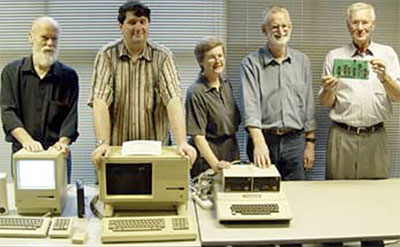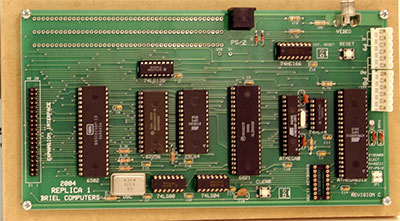A history of VMUG and iMug 1985–2020: The rise and impact of the Internet
By Noel Jackling OAM
In the early 1990s, the Internet began to grow and be accessible, at least to those VMUG members involved in education, such as Robert Charlton, Brian Livingston and Noel Jackling (all at RMIT). Towards the end of the 1990s the Internet became increasingly available to the general public and a rapidly expanding number of businesses sought to have a website presence.
In mid-1997, Robert Charlton established a web site for VMUG, which he actively ran until 2004, during the last three years of which he managed the web site from London. In 2004, professional web site developer and President, Hope Stewart, took on the management of the iMug web site and revamped it into the informational site that it is today (2020), and which she continues to manage.
The decline of printed magazines and user groups
By the late 1990s, the rise of the Internet began to impact on user groups on two fronts. First, public domain software became freely available directly and immediately. Secondly, the Internet began to replace printed magazines and meetings as a source of timely news and information.
User group magazines were out of date almost before they were printed. A compounding factor was the increased pressure of work in an era of global economic rationalisation.
Additionally, the new generation of computer users had learned to use computers at school or university, and their needs differed from those of the earlier generation. Besides, individual participation in community activities became less valued.
When this happened, membership fell dramatically and by the end of 1999, VMUG faced financial ruin. It happened so fast, that for a short time, the financial survival of the Society became dependent on a member bankrolling it until the next annual influx of subscriptions brought relief.
The only hope was to abandon the past and join the revolution! The magazine was peremptorily discontinued with the December 1999 issue being the last paper-based issue. A replacement was needed. Fortunately the way forward was already at hand, and this was recognised by the VMUG committee under Brian Livingston.
The rise of online discussion groups
In August 1999, just four months before the demise of VMUG News, an online group discussion list was introduced under the guidance and inspiration of its administrator/moderator, Michael Scheurer. This electronic group discussion list was established on the web with Oneline, a corporation that was taken over by Yahoo.
The electronic discussion list morphed into a Yahoo Group. It was initially accessed by slow dial-up modem, because broadband did not become available until 2001. Michael Scheurer had already set up a free electronic mailing list, and given interested users access. The Society knew that that was the way it had to go, and most fortunately, Michael handed over his mailing list to VMUG.
Moreover, he maintained it and moderated it for some time. This was something that was harder to do in those days when so many people were unfamiliar with how a mailing list works, and many were only starting to get email addresses—the administrative burden alone was significant, with a big turnover in members and addresses.
Michael's foresight was central to the group's survival. Along with a handful of others, he helped the Society get through a very rough period. In about 2004, Hope Stewart took over management of the list and became its administrator. Many years later this role was taken over by Robert Morsillo. Hope shifted the eList from Yahoo to Mailman.
A change of name
The increase in significance of the Group eList and the VMUG web site, the decreasing significance of meetings as a key means of providing information and problem solving and the release of the iMac with the 'i' prefix in 1998, prompted the Society, at the suggestion of Brian Livingston, to change its name.
On 17 April 2000 VMUG, or technically Mac User Group (Vic) Inc. changed its name to Internet Macintosh User Group Inc., and it came to be known as iMug. Robert Charlton designed a new logo for the Society incorporating directional Wi-Fi waves.

iMug logo designed by Robert Charlton
A change of focus of meetings
About this time, meeting presentations by such corporations as Apple, Microsoft and Adobe diminished and eventually disappeared, while presentations by iMug members, Apple resellers and others increased.
Focus ceased to be on the release of new models of Apple computers, although the progressive release of new Apple products like the iPod in 2001, the iPhone in 2007, the iPad in 2010 and the Apple Watch in 2015 meant that the Society was progressively expanding from its Macintosh beginnings.
A further snapshot of changes in technology this century can be derived by viewing the list of past meeting presentations since 2005 on the iMug web site.
(The following content has been contributed by Ian Woodside.)
Starting in 2006, Simon Clement spoke on building an iPod hi-fi. Gary Bass took us into the classroom and explained how a Mac could be used for school-based data collection in the sciences and the results then podcasted. The WWDC award-winning program 'Comic Life' got an airing in a session from one of its developers, Keith Lang.
Another memorable meeting in 2006 was a demonstration of the operation of each of four generations on Apple computers. This included Brian Livingston using an Apple I replica to run command lines on a monitor.

Four Generations of Apple Computers
L-R: Peter V. Green with a 128k Macintosh, David Turk (deceased) with a Lisa (Macintosh XL), Lecki Ord and Ian Godfrey with an Apple ][, and Brian Livingston with an Apple I function replica

Apple 1 function replica constructed from a kit by Brian Livingston and his son Campbell
In 2010, we moved to the Cloud, with Gary Bass returning to elaborate on 'iPad & Education—Up in the Education Clouds?'. The Cloud continued to be a topic for exploration when Anthony Caruana presented 'Cloud Computing'. Terry Bennet, Managing Director of Streetwise Software, demonstrated the combined use of MacMini, Apple TV, Western Digital hard disk drive and TivO as part of a high definition TV system for family use.
By 2012, there was a growing interest in websites, so there was a high demand for Charlie Crouch's talk on 'So you have a great website! Run the ruler over your site - Five things you MUST test'. Charlie, who used to work for Apple Inc. in USA, continues to be in touch with iMug from Paris.
The range of applications for the iPad grew rapidly and this was reflected in a presentation by Jane Farrell, a speech pathologist and special educator, on 'Children with special needs especially appreciate the iPad'.
2015 saw the changing retail environment taking shape and this was reflected in the talk of James Webber, CEO of Bookworld, on 'On the way down: Blockbusters, Borders … Moving Up: Netflix, Apple, Bookworld— Staying relevant in a rapidly changing technology landscape'.
A major technological innovation, that of digital printing, was brought to most of us for the first time in one session from Simon Sherrin, Senior Developer, Digital Products, Museum Victoria. His talk was on '3D Printing— changing the way we preserve the past'.
Danny Gorog, Director, Outware Mobile, demonstrated the new technology of the newly introduced Apple Watch in a presentation titled 'Don’t just use your Apple Watch to tell the time'.
In 2017, Danny reflected on the growing strength of the web in his talk 'The internet of things and more…', whilst Anthony Caruana spoke of its dangers in 'The dark tower—they don't want to hack your Mac - just you'.
In 2018, emerging new uses of mobile devices were reflected in Les Posen and Anthony Caruana's talk 'HomeKit: Hi Siri, please turn on my lights'.
In a presentation that ventured into the oft ignored world of computer games, Richard Moss, journalist, historian and freelance writer, spoke of 'Gaming and the Mac— Is it still the "black sheep" of the gaming world … and more'.
In 2019, Damien Ivereigh, CEO of ISP Launtel, addressed the nation-wide major problem of Internet speed with his address on 'What makes it so difficult for Australia to deliver high speed gigabit broadband for everyone'.
The future is unknown, but if the past is any predictor, then iMug will continue to have the presentations to address current issues.
Table of Contents
- The early years
- The 1990s—rapid rise and rapid decline
- VMUG News
- VMUG premises in Ross House
- Help Desk, Computer Training and Public Domain Software
- Meetings
- The rise and impact of the Internet
- iMug Apple Collection at Museum Victoria
- An odd occasion
- iMug Widget—a small feature to advertise meetings
- A few prominent VMUG/iMug members
- In conclusion
- Appendix 1 - Four special December meetings
- Appendix 2 - Apple Effect timeline banner 1976–1990
- Appendix 3 - Apple Effect timeline banner 1990–2006
- Appendix 4 - Libretto to 'An Apple a Day'
- Appendix 5 - Libretto to 'The Very Model of a Modern Apple MacBook Pro'
- Appendix 6 - Office Bearers
- Appendix 7 - Life Members
Download the entire History of VMUG and iMug 1985–2020 as a PDF.
 internet macintosh user group!
internet macintosh user group!